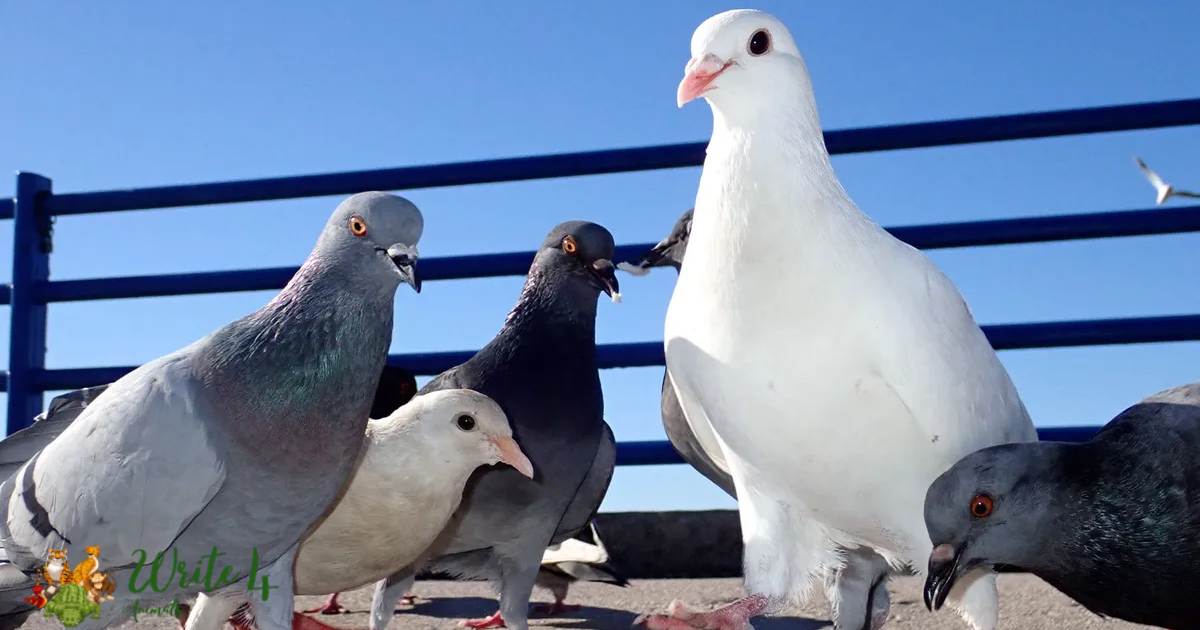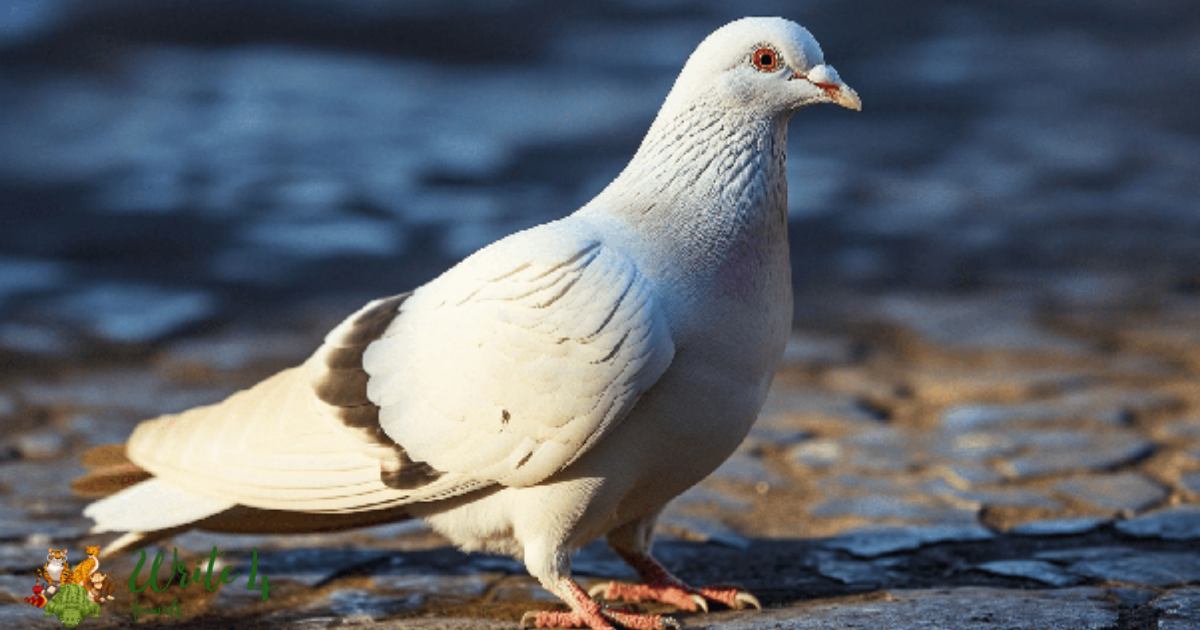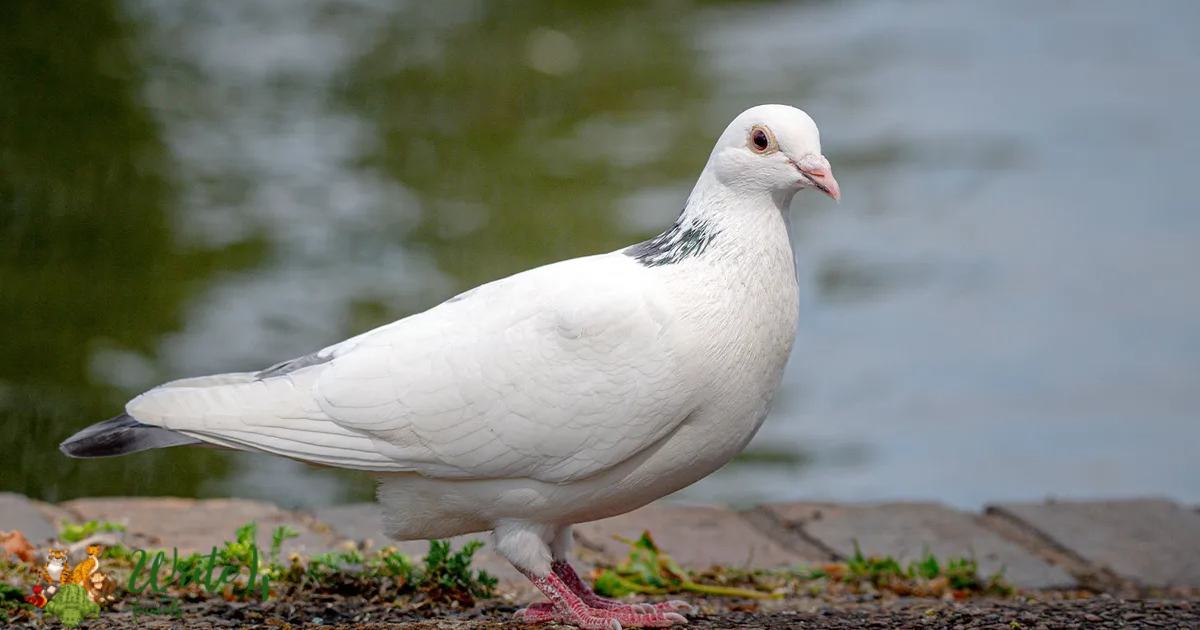Pigeons, with their distinctive cooing and graceful flight, have long captivated the human imagination. Among these feathered creatures, the albino pigeon stands out as a mesmerizing anomaly, shrouded in mystery and awe.
In this comprehensive guide, we will delve into the fascinating world of albino pigeons, exploring their unique characteristics, the science behind their albinism, their historical significance, and the challenges they face in the wild.
About Albino Pigeon
History of Albino Pigeon
The history of albino pigeons is woven into the broader tapestry of human fascination with these birds. Albino pigeons have been documented throughout history, with mentions in various cultures and societies.
In ancient times, these ethereal birds were often considered symbols of purity, peace, and even divinity. Their rare and striking appearance sparked myths and legends, further enhancing their mystique.
Over the centuries, albino pigeons have been featured in art, literature, and religious symbolism, leaving an indelible mark on our cultural heritage.
Appearance of Albino Pigeon
Albino pigeon boast a unique and enchanting appearance that sets them apart from their more common counterparts. Their entire plumage is a brilliant, pristine white, with no trace of the usual gray or colorful markings seen in typical pigeons.

The absence of melanin also affects their eyes, beak, and feet, giving them a distinctive pink or red hue.
This striking coloration makes albino pigeons a captivating sight for bird enthusiasts and photographers alike, highlighting the beauty that can arise from genetic anomalies in the avian world.
Albino Pigeon Temperament and Activities
Contrary to popular belief, the temperament of albino pigeons aligns closely with that of their non-albino counterparts. These birds exhibit the same social and communal behaviors, forming flocks and engaging in activities such as preening, cooing, and foraging for food.
Albino pigeons are known for their adaptability to urban environments, often coexisting peacefully with humans. Their gentle demeanor and graceful flight patterns make them a charming addition to the avian landscape.
Despite their unique appearance, albino pigeons seamlessly integrate into the daily activities of pigeon communities, emphasizing that, beneath the rare exterior, they are fundamentally pigeons with behaviors and instincts similar to their more common peers.
Albino Pigeon Health Issues
Sensitivity to Sunlight: Albino pigeons, lacking the protective melanin pigment, are more susceptible to the harmful effects of sunlight. Their pink or red eyes are particularly vulnerable to ultraviolet (UV) radiation, which can lead to eye damage or even blindness if they are exposed for extended periods. Pigeon keepers and enthusiasts need to provide shaded areas for albino pigeons to prevent such health issues.
Skin Vulnerability: The absence of melanin also makes albino pigeon prone to sunburn and skin issues. Prolonged exposure to direct sunlight can result in discomfort, redness, and, in severe cases, skin damage. Providing shelter and ensuring adequate sun protection is crucial for maintaining the well-being of albino pigeon.
Increased Predation Risk: In the wild, albino pigeons face a higher risk of predation due to their conspicuous white plumage. Their lack of natural camouflage makes them more visible to predators, putting them at a disadvantage compared to regular pigeons. This vulnerability emphasizes the importance of protective environments for albino pigeons.
Genetic Disorders: Albino pigeons may be more prone to certain genetic disorders associated with albinism. These can include vision impairments, respiratory issues, or immune system deficiencies. Regular veterinary check-ups are essential to monitor and address any potential health concerns in albino pigeons.
Social Stress: Albino pigeons may experience social stress due to their distinct appearance. In pigeon flocks, individuals that deviate from the norm may face challenges in social integration, potentially leading to stress-related health issues. Providing a supportive and understanding environment is crucial for the well-being of albino pigeons in group settings.
Various factors that affect the price of albino pigeon
Genetic Rarity: The rarity of the albino trait within a specific pigeon breed or lineage can significantly impact the price, with more rare genetic variations often commanding higher prices.
Pedigree and Lineage: Pigeons with well-documented pedigrees, showcasing a lineage with desirable traits and characteristics, may have higher prices due to the assurance of genetic quality.
Age and Health: The age and overall health of an albino pigeon can influence its price, as younger and healthier pigeons may be more desirable to buyers.
Breeder Reputation: The reputation of the breeder or seller can affect the price, as breeders known for maintaining high standards in breeding practices and caring for their pigeons may command higher prices.
Market Demand: Current market demand for albino pigeon can fluctuate, impacting prices. Increased demand, especially in specific regions or among collectors, can drive prices higher.
Albino Pigeon Habitats
Urban Spaces: Albino pigeons, like their regular counterparts, are adaptable to urban environments. However, they may prefer secluded areas with reduced predation risk, such as parks or areas with limited foot traffic.

Sheltered Locations: Due to their sensitivity to sunlight, albino pigeons often seek sheltered locations. This could include areas with abundant foliage or structures providing shade, allowing them to navigate their surroundings comfortably.
Human-Made Structures: Albino pigeons are known to inhabit human-made structures such as buildings, bridges, and ledges. These structures provide both shelter and vantage points, allowing them to survey their surroundings while minimizing exposure to potential threats.
Isolated Nesting Sites: Albino pigeons may choose isolated nesting sites to reduce social stress and avoid potential conflicts with regular pigeons. These sites can include ledges, eaves, or other elevated locations that offer privacy and security.
Conservation Zones: In some regions, conservation efforts target creating specific zones to protect albino pigeons. These areas aim to minimize disturbances, reduce predation risks, and provide a conducive environment for albino pigeons to thrive, contributing to their overall conservation and well-being.
Facts about albino pigeon
1. Colorless Plumage: Albino pigeons lack melanin, resulting in pure white feathers and strikingly red or pink eyes.
2. Genetic Mutation: Albinism in pigeons is caused by a genetic mutation affecting melanin production.
3. Distinctive Appearance: Their unique appearance makes them stand out in urban and natural settings.
4. Sun Sensitivity: Albino pigeons are more sensitive to sunlight due to the absence of protective pigmentation.
5. Vulnerability: Their lack of camouflage makes them vulnerable to predators, increasing the risk in the wild.
6. Ocular Impact: The absence of melanin in their eyes may lead to vision impairments and discomfort in bright light.
7. Symbolic Significance: Albino pigeons are often associated with purity and considered auspicious in various cultures.
8. Social Challenges: They may face challenges in social dynamics within flocks due to their distinct appearance.
9. Conservation Focus: Conservation efforts aim to protect albino pigeons by addressing their vulnerabilities and promoting breeding programs.
10. Urban Adaptability: Despite their challenges, albino pigeons can adapt to urban environments, often seeking sheltered locations and human-made structures.
Albino Pigeon Lifespan
The lifespan of an albino pigeon is comparable to that of regular pigeons, typically ranging from 3 to 5 years in the wild. However, factors such as predation, environmental conditions, and human interactions can influence their longevity.
Albino Pigeons vs Regular Pigeons
Pigeons are a familiar sight in urban landscapes, but among them, albino pigeons stand out as unique specimens. Let’s explore the distinctions between albino pigeons and their regular counterparts.
1. Appearance:
Albino Pigeons: Albino pigeons exhibit a pristine white plumage and striking red or pink eyes due to the absence of melanin.
Regular Pigeons: Regular pigeons have a more varied color palette, typically featuring shades of gray, white, and sometimes iridescent hues on their neck and wings.
2. Genetic Basis:
Albino Pigeons: Albinism in pigeons results from a genetic mutation affecting melanin production. Both copies of the relevant genes must carry the mutation for albinism to manifest.
Regular Pigeons: Regular pigeons have a mix of pigments, including melanin, responsible for their characteristic coloring.
3. Sun Sensitivity:
Albino Pigeons: Albino pigeons are more sensitive to sunlight due to the lack of melanin, making them prone to vision impairments and discomfort in bright light.
Regular Pigeons: Regular pigeons have melanin to protect their eyes and skin from the sun, allowing them to navigate diverse environments.
4. Social Dynamics:
Albino Pigeons: Albino pigeons may face social challenges within flocks due to their distinct appearance, potentially experiencing exclusion or aggression.
Regular Pigeons: Regular pigeons typically engage in complex social structures, with established hierarchies within flocks.
5. Predation Risk:
Albino Pigeons: The lack of protective pigmentation makes albino pigeons more vulnerable to predators, as they lack natural camouflage.
Regular Pigeons: Regular pigeons have evolved to have a balance of coloration that aids in blending into their surroundings, reducing the risk of predation.
Frequently Asked Questions
What is an albino pigeon?
An albino pigeon is a rare variant characterized by a genetic mutation that inhibits the production of melanin, resulting in a lack of pigmentation in their feathers, skin, and eyes. They typically have a pristine white appearance with red or pink eyes.
How does albinism occur in pigeons?
Albinism in pigeons is a result of a genetic mutation affecting the genes responsible for melanin production. Both copies of these genes must carry the mutation for albinism to manifest.
What makes albino pigeons unique?
Albino pigeons are unique due to their distinct appearance, sensitivity to sunlight, and the challenges they face in social interactions and survival in the wild. Their rarity also contributes to their uniqueness.
Are albino pigeons more susceptible to predators?
Yes, albino pigeons are more vulnerable to predators. The absence of protective pigmentation makes them conspicuous and easier targets for predators in comparison to their pigmented counterparts.
Do albino pigeons have vision problems?
Albino pigeons often experience vision impairments due to the absence of melanin in their eyes. This can lead to increased sensitivity to bright light and potential discomfort.
Do albino pigeons face social challenges?
Yes, albino pigeons may face social challenges within flocks. Their distinct appearance can lead to exclusion or aggression from their normally colored counterparts.
Are albino pigeons considered auspicious in any culture?
Yes, in some cultures, albino pigeons are considered auspicious symbols, often associated with purity and good luck. Sighting an albino pigeon is sometimes regarded as a positive omen.
How can we support the conservation of albino pigeons?
Supporting conservation efforts that focus on creating safe environments, raising awareness about their vulnerabilities, and promoting breeding programs for genetic diversity can contribute to the well-being and conservation of albino pigeons.
Can albino pigeons adapt to urban environments?
Yes, albino pigeons can adapt to urban environments. They may be found in parks, on buildings, and in other urban structures, seeking sheltered locations and areas with reduced predation risks.
Recommended
1. Shiba Inu Dog Price in Usa, India and other Countries 2024
2. Albino Monkey: History, Facts and More | albino monkeys
